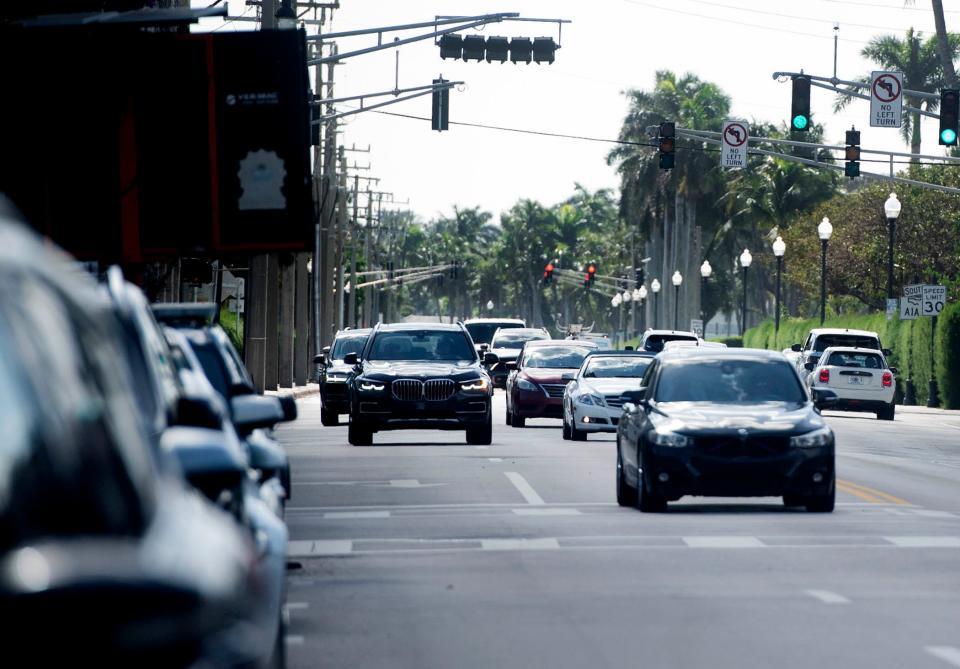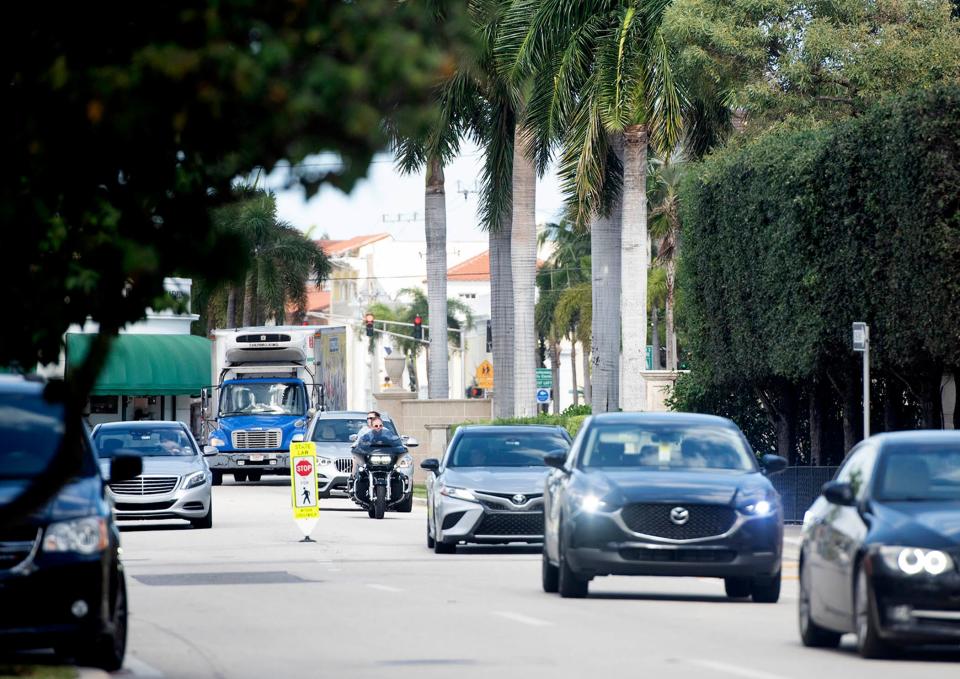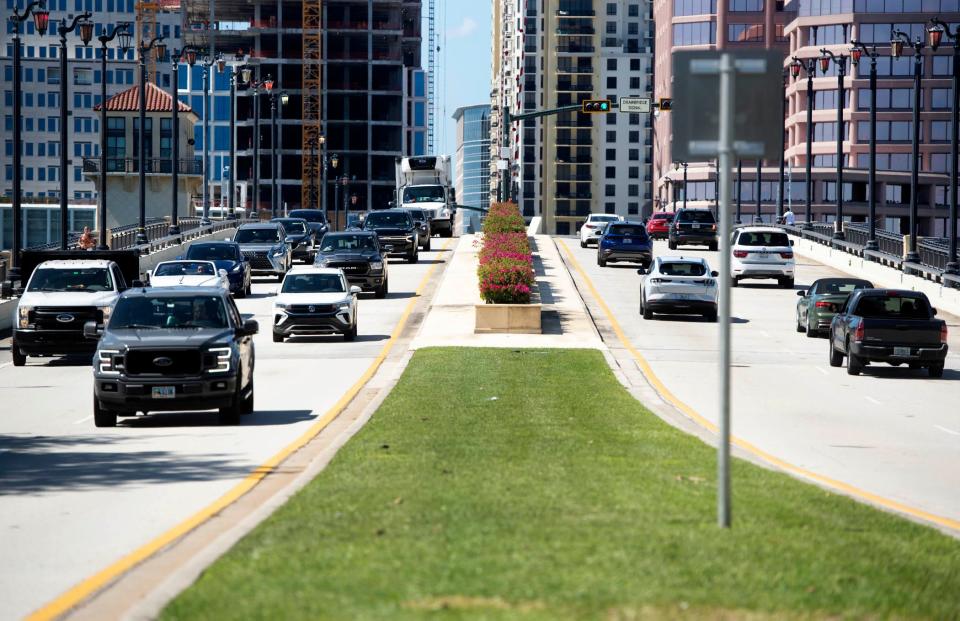Palm Beach works to find solutions for traffic congestion
In a town where there are few options to widen roads, the traffic jam has almost become a rite of passage, especially during season.
Palm Beach has long been plagued by traffic tie-ups. And with an ever-growing population boom fueled by post-pandemic growth, town officials are working to find solutions to help Palm Beachers get where they need to go — in a more timely manner.
More: Palm Beach police work to stem stolen cars as number passes 2022 total
"There is little to no opportunity to create more capacity on the island," said Paul Brazil, town Public Works director. "The island is built out and the roadway system is what it is."
Aside from widening roads, there are things that can be done to help alleviate the issues — steps on which the town is working with the county and state to implement. "We constantly monitor traffic, and we intervene where we can," said Maj. John Scanlan of the Palm Beach Police Department.

A history of traffic tie-ups
Traffic congestion has been an issue in Palm Beach for years and has grown progressively worse, as reflected in data collected by the Florida Department of Transportation and Palm Beach County's traffic division, Brazil said.
Not only does Palm Beach have to deal with the number of cars on the island at any given time, but there also are effects from construction — both private and public, including the town's ongoing project to move its utility lines underground — on the right-of-way, officials said.
More: PBIA on track to see record number of arrivals, says airline group executive
Earlier this year, a long-planned project to paint the Royal Park Bridge was moved to the off-season to create as little impact on traffic as possible, officials said. State contractors moved quickly to complete the painting project months ahead of schedule, the town said.
Elsewhere, officials have changed traffic patterns to help vehicles move more smoothly. In April, the town announced it would change the traffic pattern at Sunset Avenue and Bradley Place near Publix. Officials are always watching for opportunities to make similar changes, Brazil said.
More: Palm Beach Police: Barton Ave.'s ocean block by church will become a one-way street

The town announced Tuesday that it will make the ocean block of Barton Avenue a one-way westbound street, meaning cars will no longer be able to travel toward the beach from the intersection of Barton and South County Road next to the Episcopal Church of Bethesda-by-the-Sea. The change takes effect Dec. 15.
Though there was a distinct drop in traffic counts in 2020 because of the COVID-19 pandemic, the steady rise officials had seen before that year picked right back up where it left off, according to Florida Department of Transportation data.

FDOT monitors several traffic points throughout Palm Beach County, including one on the east side of the Flagler Memorial Bridge, before Royal Poinciana Way's intersection with Cocoanut Row. There were an average of 17,909 cars per day last year, up from 17,565 per day in 2021, the data show. In 2020, the average number of vehicles per day to pass that spot were 15,119; the year before, there were 17,223.
Other tricky points around town that frequently become congested, according to Brazil: Royal Palm Way and Royal Poinciana Way, and around the Publix store on Bradley Place.
Smarter signals to help traffic move
Last year, the Town Council approved a $1.5 million plan to install adaptive, or "smart," traffic signals throughout the town. The system was installed over this past summer, and the program is now learning and processing the data it has received so far, Brazil said.
Palm Beach County has used adaptive traffic signals to help alleviate congestion on major roads for about a decade. It isn't the first time the town has used an adaptive system. Officials turned to the technique in 2017 in preparation for then President-elect Donald Trump's visits to his Mar-a-Lago Club and expected traffic issues at the time.
Controllers at each intersection in Palm Beach were replaced and connected to new software that is programmed with intervals that take the time of day into account when timing how traffic signals change from color to color, Brazil said. The adaptive nature of the software means that the signals essentially talk to each other and make other adjustments based outside of the time of day while coordinating with other nearby intersections.
"We anticipate seeing improved movement through intersections before the end of the season," he said, adding: "Please realize that no system can overcome roads that have more cars than capacity."
The updated system should help with one of the major traffic pain points faced by Palm Beach drivers: the opening and closing of any of the three bridges that connect the island to the mainland over the Intracoastal, Brazil said.
Adjusting bridge opening times
When it comes to bridges, the town has worked with the Coast Guard and FDOT to change the schedule of when the three bridges to the town — the Flagler Memorial Bridge on the North End, the Royal Park Bridge in Midtown and the Southern Boulevard Bridge — will open for boat traffic to pass underneath.
All three bridges have been approved for limited openings during the season, Scanlan said. The six-month alteration to the bridge opening schedule means there will be one opening per hour instead of two from 7:30 to 9:30 a.m. and from 4 to 6 p.m. each day, he said, noting that the updated schedule should be implemented soon.
"There's only so many bridges and only so many ways to get to those bridges, and so it backs up," Scanlan said.
In addition to adjusting when the bridges open and close during peak traffic hours, the town is working with Palm Beach County's traffic management department to better sync the signals on either side of each bridge, he said.
Parking poses problems
A dearth of available parking spaces in Palm Beach can contribute to traffic congestion, officials said.
"A lot of the people who are coming over here are coming here to either go shopping or go to the beach or go to eat at one of the restaurants," said Palm Beach police Lt. Paul Alber, who oversees the department's parking enforcement and strategy. "They need a place to park."
The number of parking spaces is "fairly limited," he said: There are 1,897 on-street parking spaces, and nearly 60% of those are free, though they may be time-limited. Those who are unable to find parking end up circling their destination and contributing to congestion, Alber said.
"We are trying to take a more proactive approach to our parking enforcement," Alber said.
The Town Council, in an effort led by member Lew Crampton, has tackled parking issues, developing a plan to make the process smoother. The plan includes adding more paid parking, and a recently implemented parking sticker for residents. The decal will give residents two free hours of parking in a metered spot.
The police department also added new parking control officers and is recruiting to fill additional positions, Alber said.
Over the years, the council took what Alber called a "micro approach" to parking issues, which created pockets of different parking policies throughout the town. The new parking plan takes a more comprehensive approach, he said. There are a few places throughout the town where parking can cause a particular issue, Alber said. There is high demand along the beach, along with areas near the beach where free parking is available, he said.
"A lot of the savvy beachgoers are opting to park one block over in front of the businesses so they don't have to pay the $7 per hour for beach parking," Alber said.
The town is trying to crack down on merchants and employees who park in front of or near their businesses, limits parking availability for other people, he said.
"They have a limited amount of options for where to park to begin with," Alber said. "We definitely need to change the way people commute and encourage alternate methods, especially for some of the employees, to minimize the traffic and parking impacts."
All of that is a work in progress, he said.
With limited parking spaces available, the Town Council has considered funding some ride-share options that could help alleviate the demand. One of those options is Circuit, offered by the city of West Palm Beach and its Downtown Development Authority. Rides are free around West Palm Beach, with a recently added fee for trips to, from and around Palm Beach of $4 for the first passenger and $1 for each additional person.
Another option recently reviewed by the council: Rove, an app-based company led by Jack Brinkley-Cook, model Christie Brinkley's son, and Gianpaolo de Felice, fashion designer Donna Karan's son-in-law. Rove already offers its service during the summer in Montauk, East Hampton and Sag Harbor, N.Y. If approved, Rove would have winter service in Palm Beach and Aspen, Colo.
The service would be free and feature 10 Tesla vehicles to carry customers anywhere from Wells Road in the north to the southern town limits. The council reviewed the program at its Nov. 14 but delayed a decision until December, when it hopes to have an opinion from Town Attorney John Randolph on how to handle advertising on Rove's vehicles.
"The town recognizes the need to address the parking and traffic, and the Town Council is working diligently toward coming up with solutions," Alber said.
This article originally appeared on Palm Beach Daily News: Palm Beach traffic: Officials work to find solutions for congestion

